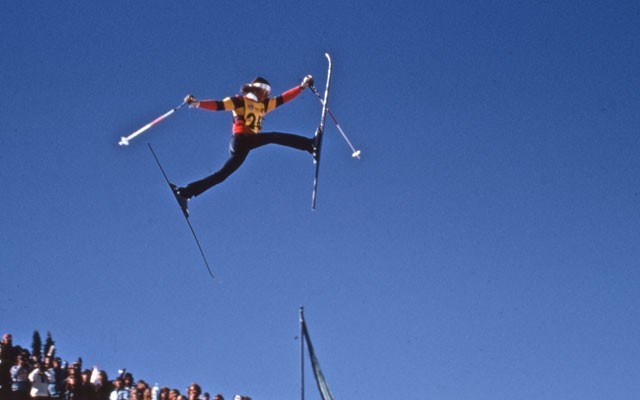Eddie Ferguson had the best seat on the chairlift when freestyle skiing was in its infancy.
The Boise-born skiing legend known as "Airborne Eddie" helped develop the sport in the early 1970s as it quickly boomed in popularity with sponsors quick to jump on board, helping to create professional competitions even before a true amateur scene came to fruition.
Ferguson is one skier who looks back on that time in Brian Gilmore's Dog Days of Summer documentary, which will be screened as part of the Whistler Film Festival's Adventure Film Series. The documentary will be shown this Saturday, May 16 at 6:30 and 9 p.m. Ferguson and Gilmore are both slated to be in attendance at Millennium Place in the first visit to the resort for both in several years.
Ferguson hasn't been to town since the mid-'70s, he estimates, and is excited to see what the town has become.
"It's been years since I've been there. I'm looking forward to seeing it," Ferguson said from his Chelan, Wash. home. "I know I'm in for a treat."
Ferguson fed his hunger for skiing at a young age, starting to teach at age 14 and achieving full certification at age 16 when instructors generally would be at least 18 before making that level. He felt his ability to instruct strengthened his own skiing, which in turn gave him the gumption to try new tricks on the hill.
"I had this tremendous basis in the basics of ski technique through teaching skiing and through getting certified. I stood on a pair of skis pretty squarely and that gave me a real good in into freestyle skiing when it came around because I was already doing a lot of that stuff," he said. "I was doing helicopters and I was doing shoulder rolls and I was doing front flips.
"Moguls skiing was certainly my forte."
Being in the right place at the right time at Sun Valley Resort in the early 1970s was also a factor, Ferguson explained. Representing Sun Valley, he won Skiing Magazine's Hot Dogger of the Year Award in 1973.
"It was the perfect time for the rebellious skier to want to go and do something different. There was an arena for it and the people loved it," he said. "We had the sponsors. We had the media coverage. We had the skis."
Helping to spread the sport were Ferguson's freestyle camps, which started at Crystal Mountain in Washington in 1973 but were later held in Colorado, Wisconsin, Canada and Europe. Eventual world champions like Marion Post and Mark Stiegemeier passed through the camp as students before going on to glory.
Passing the sport onto the next generation was a major step for its development, as it allowed amateur competitions to take root and help build a case for inclusion at the Winter Olympic Games. Moguls and aerials were introduced at the 1988 Games in Calgary, making freestyle skiing a rare sport developed in the United States to become accredited at the Olympics. Moguls became a medal sport in 1992 in Albertville, France, while aerials was promoted two years later in Lillehammer.
Establishing rules for each sport initially proved to be challenging. Ferguson recalled his first aerials competition in 1972 where there were 10 jumps, of which a competitor had to complete three in a row without stopping. The skier received bonus points if a fourth jump was completed. He added the landing area was sparse.
However, organizers quickly began implementing a standard for events to increase safety.
The standards, especially in moguls, have become a little too stringent, Ferguson feels. He noted each course seems to be uniform, "cookie-cutter" in design with every one carefully groomed and tended to. The turning point, he feels, was the Olympics.
"The moguls have become disappointing to me because they're so manufactured. It's not a free run. It's a manufactured run," he said. "The Olympics gave birth to that transition from real freestyle moguls skiing to what it's become today."
Though the courses themselves have changed, Ferguson finds himself in awe of today's athletes
"I watch it on TV a lot, and in real motion, regular speed, I can't hardly count the number of spins these guys are doing," he said. "They've gone so far past where I was when I retired in 1979, I can't even wrap my brain around it. I couldn't hold a candle to these guys."
Director Brian Gilmore was an avid skier growing up in Michigan and recalled the original freestyle era. His lifelong goal was to document and pay tribute to the sport's origins, which he accomplished with the movie.
"Freestyle skiing today is, I believe, the most popular attraction at the Winter Olympics as far as spectators go," he said. "There's a disconnect where the sport is today and the origins, which is strongly connected to this original small group of skiers."
The Bellingham, Wash. resident, who is a school counsellor, was last in Whistler in 1984. He was a regular at Toni Sailer's summer camps, first as a student, then later as an instructor.
"I got to watch the village being built (in 1981)," he said. "Then I came back in 1984 and saw all the changes.
"There's something very special about being able to go up to Whistler back in 1978, '79. Even the road up from Vancouver, the highway was small, and you felt like you had the whole mountain to yourself if you were up on the glacier during the summer."




